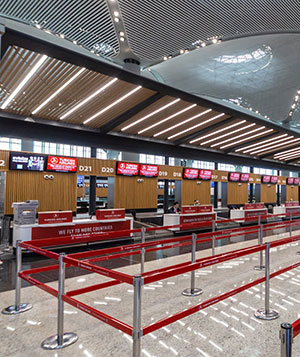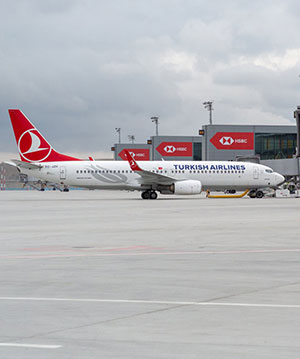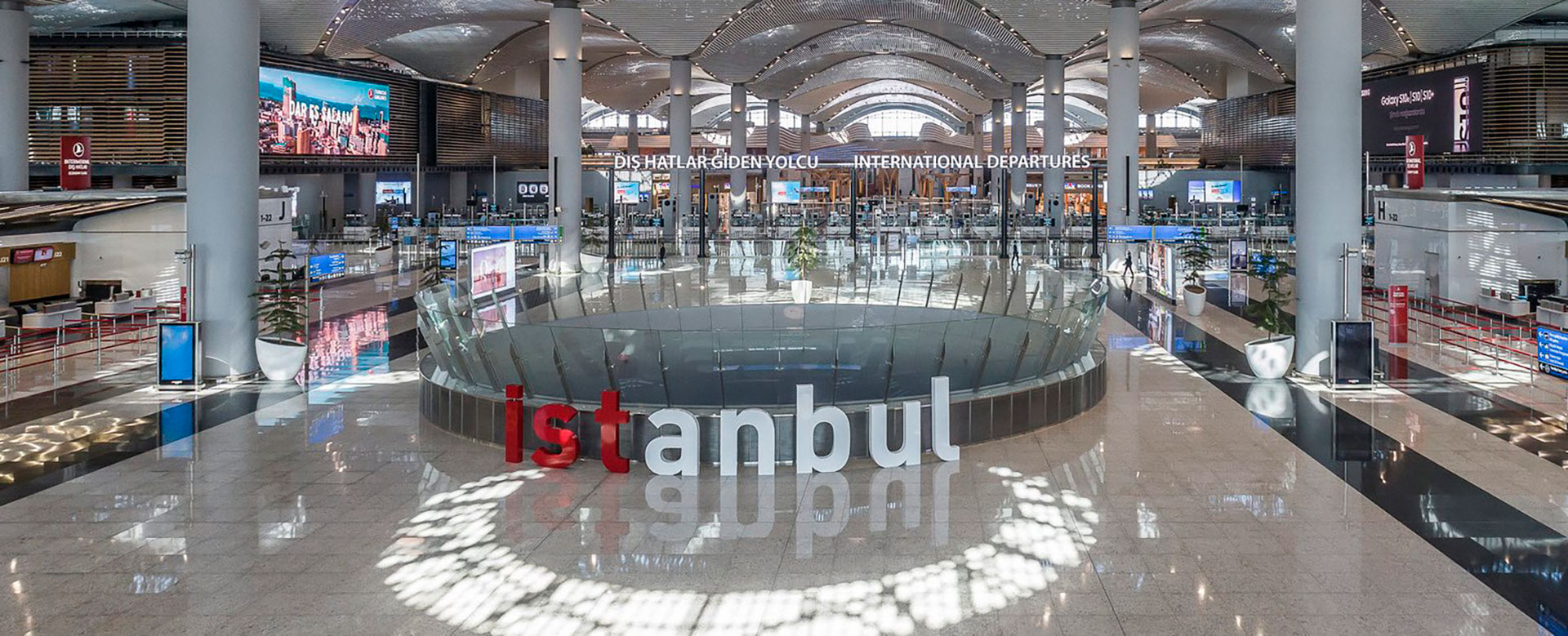
Istanbul Airport Case Study
AtlasIED Helps New Istanbul Airport Streamline Gate Announcements, Improve Traveler Experience
Highly intelligible AtlasIED audio solutions running on a Dante™ network sets a new precedent in airport technology
Building a new airport is no small feat. Today’s airports are high-tech, self-contained communities created to accommodate millions of travelers annually. Erecting a new airport is akin to creating a new city out of thin air – something that doesn’t happen every day.
But that’s exactly what occurred when Istanbul Airport opened in April 2019. Not only does Istanbul Airport represents brand-new construction – an oddity in the world of aviation – it also happens to be the largest airport in Europe under one roof.
On Saturday, April 6 at 2 PM, the first flight took off from the new Istanbul Airport to Ankara, with Baris TK, a member of the Titan Intelligent Building Technologies team who installed the AV and technology systems in the new airport, on the flight. “The 70 million passenger Ataturk Airport moved in 33 hours from Ataturk Airport to the new IGA,” Mehmet Bülent Akinci, founder and CEO of Titan Building Systems, said.
Replacing the aging Istanbul Airport, IGA is currently able to accommodate 90 million passengers per year in a single terminal. As the hub for Turkish Airlines, it’s vying to overtake Atlanta Hartsfield-Jackson International Airport as the world’s busiest airport.
Not surprisingly, the airport communications system is a key element in the airport’s success, and the size of the terminal meant that only a handful of companies were qualified to provide the technology for the communications system.
Titan went above and beyond, integrating the audio video systems on a Dante™ network which required tireless effort on the part of Titan programmer Chris Deatrick. “He almost re-wrote the Dante™ book for us so his controllers would talk to the rest of the smart devices,” Akinci said. “He also spent days and hours on the phone supporting us.”
Titan Intelligent Building Technologies is a top international integration firm with offices in Istanbul, Ankara, and across the Middle East. Limak Holding, a Turkish conglomerate, was the general contractor on the project.
When it came to the airport’s paging systems, AtlasIED, a global manufacturer of comprehensive audio solutions for commercial AV and transportation industry environments, responded to the performance spec laid out by the architect, Grimshaw. AtlasIED’s system proved it could meet or exceed expectations for intelligibility, reliability, security, and scalability.
AtlasIED’s track record also spoke for itself in helping secure the contract. In the bid for the job, the manufacturer submitted the requested technical response form, along with a copy of a map showing how many airports, worldwide, use AtlasIED equipment for flight announcements, paging, and Mass Notifications and Emergency Communications (MNEC) systems. “There’s a reason we have so many locations on the map,” John Goodrich, AtlasIED Director, Global Installed Systems, said.
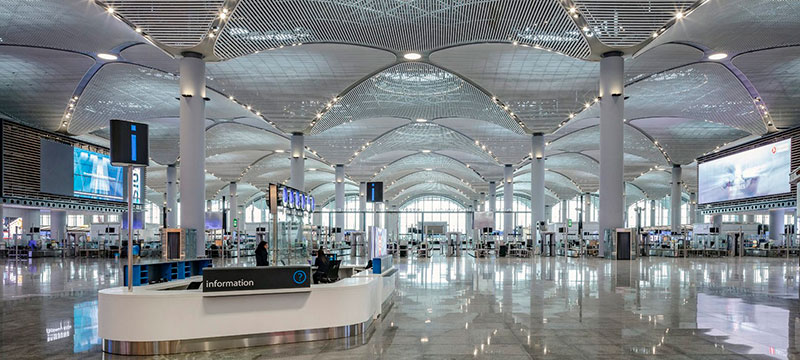
With the expertise and the infrastructure to accommodate such a large installation, AtlasIED and Titan set to work addressing the challenges of designing systems to deliver crystal clear audio to one of the world’s largest, busiest, and arguably most important, airports, serving as a gateway between Europe and Asia.
With three runways and one terminal spanning 15 million-square-feet, Istanbul Airport can currently handle 90 million passengers annually. By the time the airport is complete, it will be larger than the island of Manhattan and will accommodate up to 200 million passengers annually – surpassing Atlanta in both size and volume.
Istanbul Airport’s single terminal has 166 gates across 5 piers, with a large center rectangle that connects all five. The integrator installed 166 AtlasIED GLOBALCOM®.IP programmable touch screen digital communication stations with handheld microphones and 27 stations with gooseneck mics, powered by AtlasIED’s Flight Announcement System Core software with a Prizm Core Database. The system runs on eight separate GLOBALCOM® Layer 3 IP controllers with GCK software, and four GLOBALCOM® rack-mounted power supplies, with an additional four power supply modules for redundancy.
The AtlasIED system offered all the functionality Istanbul Airport needed, including advanced announcement scheduling, text to speech support, and automated, zone-specific bells and tones.
Offering greater insight into the size of the system installation, Goodrich revealed the project used 1,320 individual amplifier circuits in the AtlasIED TitanONE T112 series.
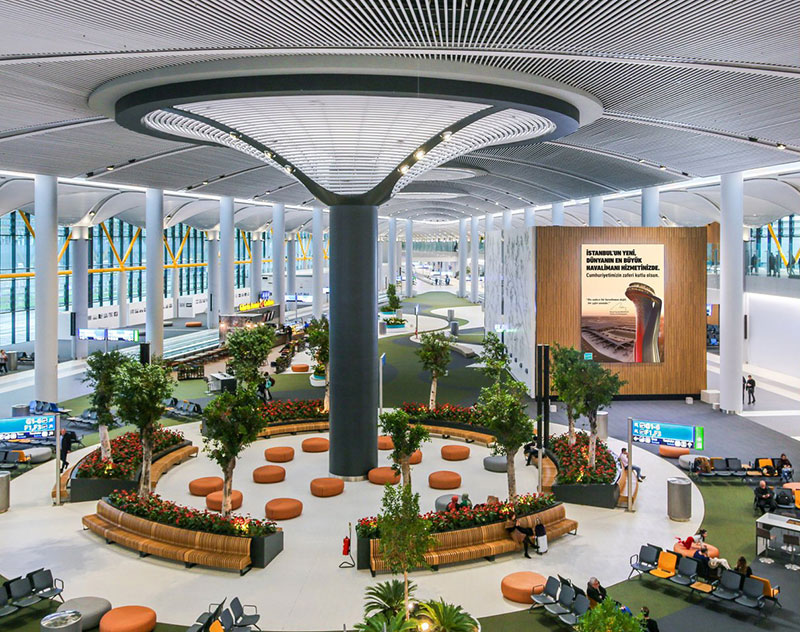
The TitanONE T112 is a networkable system offering IEDNet+ IP-based system control and digital audio transport via Dante™. Istanbul Airport represented AtlasIED’s first major deployment of the TitanONE using Dante™.
Because the airport required real-time audio with no latency, the AtlasIED team, including international sales manager Steve Youngson, worked closely with Titan to ensure the dynamic routing necessary to ensure superior audio with zero latency.
This required working with the team on networking requirements to ensure adequate bandwidth. “The digital audio transports we use, including Dante™, require the highest quality of service,” Goodrich said. “We’re at the top of the list.”
Quality of Service (QoS) describes the order in which bandwidth is distributed for various applications on a network. “Leave the buffering and caching for your Excel files and telephone calls,” Goodrich said. “Our audio has to go right to the top, live, with no latency.”
TitanONE T112 also integrates IED’s world-renowned SystemAssured™ Supervision for system monitoring and fault detection for enhanced reliability in situations, like international airports, where a system simply cannot fail.
The massive scope of the project and the networking requirements for the Dante™ system notwithstanding, Goodrich said, “The biggest challenge right off the bat in an airport of this size is acoustics and intelligibility.”
Features inherent in the GLOBALCOM® system help ensure intelligibility in the busiest of airport environments. The system offers automated sound level adjustment based on real-time environmental (ambient) noise analysis, a necessity in busy airports with multiple announcements and background noise.
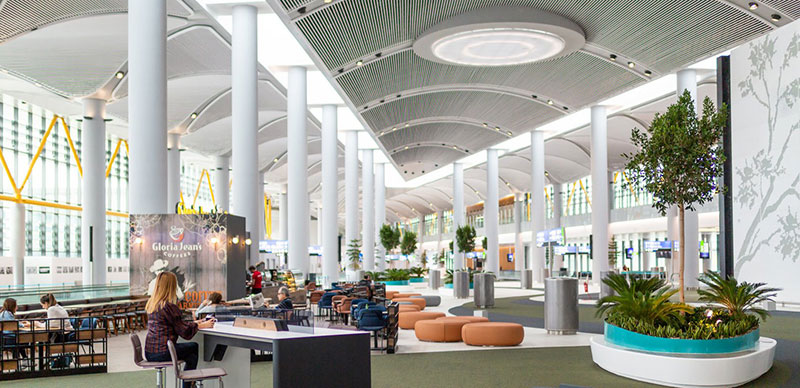
The system automatically times boarding announcements so adjacent gates aren’t competing with each other for intelligibility and there is no crosstalk.
In addition, the state-of-the-art condenser mics in the GLOBALCOM® systems use sophisticated compression and digital signal processing technology to ensure a clear signal without feedback, even if the person talking is just a foot or two away from the speaker.
The microphone processor also conditions the audio to compensate for variable voices. “Whether you have a young gate agent who is just ripping into the mic, or someone who is virtually whispering, the audio will come out at exactly the same level,” Goodrich said.
However, even AtlasIED’s inherent sound intelligibility needed reinforcement from best-in-class directional loudspeakers. With expansive 60-foot ceilings and a breathtaking modern design that uses lots of metal and glass, there was “no winging it,” when it came to intelligibility, as Goodrich put it.
“High ceilings make it hard but doable if you know what you’re doing,” he said. “With a big building, you need the right tools, including microphones and loudspeakers with directional control.”
A collection of 300 Renkus-Heinz steerable arrays delivered sound across the terminal’s gates and dozens of shops and restaurants. Goodrich noted that steerable arrays cover more territory with fewer speakers than traditional ceiling speakers, permitting a wide, asymmetrical sound dispersion pattern.
Akinci noted that his team, including designer Ricardo Castro, spent long days and nights making it happen, and, as of mid-April, were still working to tweak the system to audio perfection. “It required a huge effort from Ricardo to design this from the very beginning and make it sound beautiful,” Akinci said.

Another significant challenge cropped up days before the airport’s opening. “A very critical and major decision was made as of last week,” Akinci explained. “Just before opening we started replacing the Moxa switches by Cisco. By midnight on Friday we completed the Cisco transition and, 14 hours later, the system was working. This is a miracle, and we were very lucky that miracle happened to us.”
The goal of any airport, of course, is to keep people moving through it. Goodrich likens the airport to a landlord and the major airlines as tenants. Although the shops and restaurants within an airport are also the tenants – and keeping flyers in the airport will, to some degree, encourage them to spend money– the main goal is to keep the carriers happy.
Istanbul Airport, which was built exclusively as the main hub for Turkish Air, has incredible incentive to keep their primary airline happy. “The time that plane spends on the ground is just a cost,” Goodrich says. “The goal is to get people back on that plane, where it’s generating revenue. So, anything that can make that more efficient for the airline is all good.”
AtlasIED’s GLOBALCOM® system provides automatic or semi-automatic gate boarding announcements in the language of the departure city and arrival city, as well as other major languages used in the region.
Goodrich noted that programming boarding announcements in Turkish posed a challenge because the company had not recorded such a massive number of announcements for Turkish Air in the native language before.
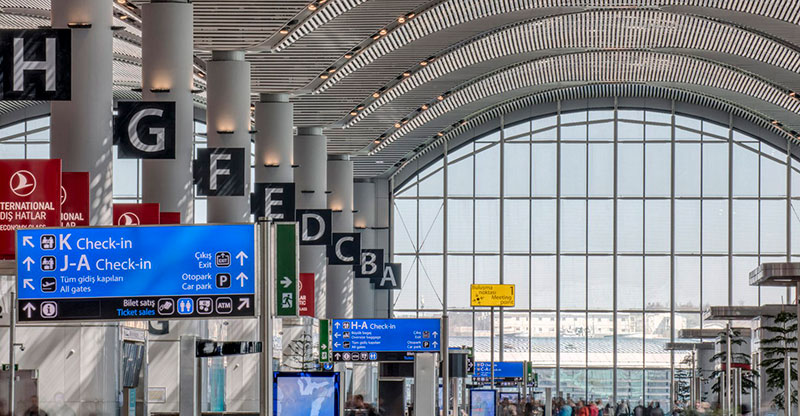
“Once we record flight announcements, we keep the information updated and can [provide it] to any airport requiring that flight information. But when you’re translating to another language, you have to make sure the wording is consistent with the native language. Even the way they recite numbers might be different,” Goodrich explained.
Airport gate personnel can run flight announcements from the integrated touch screen or from a third-party Flight Information Display Systems (FIDS). The software, additionally, can be accessed as a web application from any internet-enabled workstation.
“The gate agent can use the touch screen or workstation app to trigger the boarding sequence,” Goodrich explained. “Or they can choose a fully automatic version, where the sequence begins based solely on the FIDS data, which reports through secure channels when a plane has landed.”
Citing a “good construction schedule by a really good general contractor,” along with a systems integration firm that knew their job, Goodrich said the project was a win for all involved.
“I am sure we will be doing many, even more challenging projects together,” Akinci said. “With this experience under our belt, I am sure we will continue to grow in our success.”
The new airport promises to increase tourism to Istanbul and could also give Turkish Airlines a greater market share of connecting flights from the U.S. and Western Europe to the Middle East, where it is competing with three major carriers.
The state-of-the-art communication systems befit the airport’s modern design and, more importantly, overcome the acoustical challenges of glass walls, metal structures and high ceilings to provide the intelligibility to keep things moving in what may soon be the world’s busiest airport.
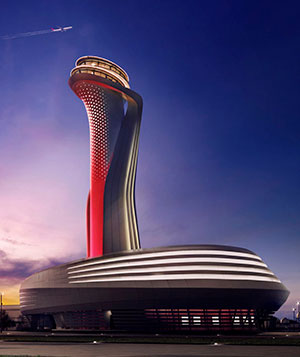
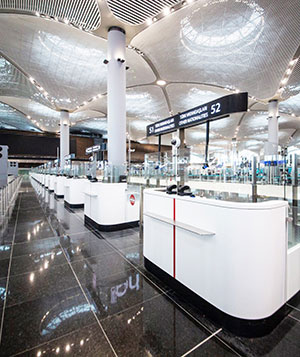
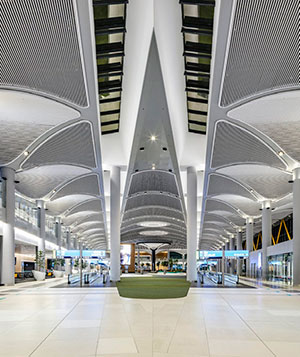
- 166 AtlasIED GLOBALCOM®.IP programmable touch screen digital communication stations with handheld microphones
- 27 stations with gooseneck mics, powered by AtlasIED’s Flight Announcement System Core software with a Prizm Core Database.
- Eight separate GLOBALCOM® Layer 3 IP controllers with GCK software
- Four GLOBALCOM® rack-mounted power supplies
- Four power supply modules for redundancy
- 1,320 individual amplifier circuits in the AtlasIED TitanONE T112 series
- TitanONE T112 also integrates IED’s world-renowned SystemAssured™ Supervision for system monitoring and fault detection for enhanced reliability in situations, like international airports, where a system simply cannot fail.
